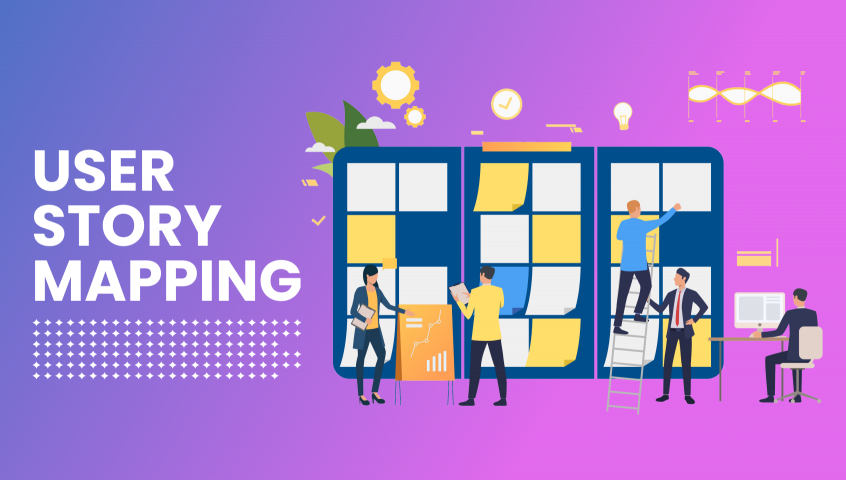As a business owner, product developer or agile team, you may identify an improvement need, new idea or product for your organisation or business. What’s most paramount is ensuring that your improvements, ideas or product meets the needs of the customers which is the critical reason for embarking on the project.
The “What” behind user story mapping?
User story mapping is the technique used to describe a user’s journey of a product feature, idea or process from the actual user’s point of view which informs the development of the new product, idea or process.
By using this technique, the user shows you what features or processes require improvements and what they wish to see then the agile team goes ahead to develop such product feature. This ensure both you and the users are happy with the final product or idea and that it meets the needs for which it is developed.
Why use user story mapping?
The user story mapping techniques are used for spotting and mapping the user needs in a much simpler and easier fashion ensuring that the final products meet the actual needs of the user and to make changes to resources in a timely manner. Eventually it presents as a roadmap of the whole project, this makes it easy to engage with the relevant stakeholders. It’s used to improve understanding of the customers and to prioritize work.
User Story Mapping and AI
AI has now made it easy to generate user stories which is required for user story mapping. Writing user stories can be a time-consuming task but with tools like ChatGPT, ideas can be generated, stories can be written in consistent forms, validated by user feedback and improved by agile teams.
Benefits of user story mapping.
The bigger picture: With user story mapping, you can visualise at a higher level enabling you to see issues much clearer and its associated bottlenecks.
Provides detailed view of what needs to be solved: User story mapping helps to provide details of what a product feature or solution solves. This is of course the main benefit of the technique as it clearly indicates the need of the user and what the agile team needs to do to deliver the final product or idea.
Identifies gaps: Early identification of problems is always better than later or post-delivery. Resource wastes are also limited due to this. Imagine delivering a digital platform to shell which helps to optimise the distribution of fuel products across a region and show related data but you discovered along the way that data relating to fuel cargo ships are not capture hence losing a part of the big picture.
Reduces the chances of failing: Failing to deliver what the customer wants is the last thing needed having committed resources, time and effort. The use of user story mapping helps to limit such. This ensures your resources and assets provide a return on investment. The technique helps you identify the areas to optimise.
Identifies fit: With story maps, you can see how the user’s needs are mapped to the proposed products and the required changes to be made.
How useful are user story mapping in business?
It is designed to help prioritise: With workload constantly on the increase, managers, entrepreneurs and agile teams spend an awful amount of time trying to decide where and what to place their time and resources on. The use of user story mapping makes it easy to set these prioritises while delivering value to the customer, hence increasing loyalty.
Value creation: The fact that it enables the user to interact with a product or process while the interaction is captured, enables the developer to optimise the interaction there by creating value opportunities.
Identifies challenges: User story mapping provides a bird’s eye view of the user’s interaction and opportunities for optimalisation. This ensures that both challenges, and its root causes are identified quickly.
Creates a unifying effect across the team: Due to the way the technique is designed, the best results are achieved when more stakeholders engage and interact in the process. So collectively, goals are shared and understood which contributes to the finished product and meets the needs of the user.
Culture of continuous improvement: Continuous improvement is a key part of User Story Mapping. Stories are grouped by priority which is transformed into different interactions and then the various stages of the products are created.
Steps to creating result driven user story maps.
- Know who your customers or users are.
- Spend identifying the issues.
- Identify the stories.
- Prioritise the actions.
- Identify challenges.
- Spend Preparing the sprint.
What happens post user story mapping?
- Deploy functionalities.
- Prioritise the product.
- Dashboard monitoring.
In an environment where change is constant, flexibility is key ensuring provision for swift changes as parameters around your project, teams, business or organisations changes.
Hopefully, this content convincing of the benefits of using the technique. Would like to hear from you and what you think about it.
Contact info@enebusinessstrategies.com to;
Book a user story mapping workshop.
Book a free 1 hour one to one consultation session.
Join The Academy: A membership programme designed for professionals and entrepreneurs. Providing business learning content and business networking opportunities.


